A Wi-Fi FTM-Based Indoor Positioning Method with LOS/NLOS Identification
Abstract
:1. Introduction
- (1)
- In order to discard the NLOS error, an identification model is proposed. Differing from other Gaussian-based models, which have established two models for LOS and NLOS, the model presented here only needs to establish one model in order to adapt to the complex indoor environment.
- (2)
- To solve the difficulty of setting parameters, we have researched and fit the relation between RSSI and ranging results, achieving adaptive settings.
2. Theoretical Framework
2.1. RTT-Based Ranging Model
2.2. Propagation of Wi-Fi Signals
3. The Proposed Indoor Localization Method
3.1. Overall Structure of the Proposed Method
3.2. The Identification Model of LOS/NLOS
3.2.1. The Determination of d
3.2.2. The Determination of μ
3.2.3. The Determination of σ
- (a)
- The variances of RSSIs were directly calculated, according to Equation (7).
- (b)
- All the RSSIs were counted in a certain interval and the probabilities of each RSSI were calculated. Then, the Gaussian regression was performed on the probability and the corresponding RSSI. σ of the Gaussian model was taken as the σ of the current distance.
3.3. Single Point Positioning
4. Experiment
4.1. Evaluation of the Identification Model
4.2. Evaluation of Proposed Positioning Method
5. Discussion
Author Contributions
Funding
Acknowledgments
Conflicts of Interest
References
- Bi, J.; Wang, Y.; Li, X.; Qi, H.; Cao, H.; Xu, S. An Adaptive Weighted KNN Positioning Method Based on Omnidirectional Fingerprint Database and Twice Affinity Propagation Clustering. Sensors 2018, 18, 2502. [Google Scholar] [CrossRef] [PubMed] [Green Version]
- Doiphode, S.R.; Bakal, J.W.; Gedam, M. A hybrid indoor positioning system based on Wi-Fi hotspot and Wi-Fi fixed nodes. In Proceedings of the 2016 IEEE International Conference on Engineering and Technology (ICETECH), Coimbatore, India, 17–18 March 2016; pp. 56–60. [Google Scholar]
- Cao, H.; Wang, Y.; Bi, J.; Qi, H. An Adaptive Bluetooth/Wi-Fi Fingerprint Positioning Method based on Gaussian Process Regression and Relative Distance. Sensors 2019, 19, 2784. [Google Scholar] [CrossRef] [PubMed] [Green Version]
- Jiang, H.; Peng, C.; Sun, J. Deep Belief Network for Fingerprinting-Based RFID Indoor Localization. In Proceedings of the ICC 2019—2019 IEEE International Conference on Communications (ICC), Shanghai, China, 20–24 May 2019; pp. 1–5. [Google Scholar]
- Sevrin, L.; Noury, N.; Abouchi, N.; Jumel, F.; Massot, B.; Saraydaryan, J. Characterization of a multi-user indoor positioning system based on low cost depth vision (Kinect) for monitoring human activity in a smart home. In Proceedings of the 2015 37th Annual International Conference of the IEEE Engineering in Medicine and Biology Society (EMBC), Milan, Italy, 25–29 August 2015; pp. 5003–5007. [Google Scholar]
- Tian, Q.; Wang, K.I.; Salcic, Z. A resetting approach for INS and UWB sensor fusion using Particle Filter for pedestrian tracking. IEEE Trans. Instrum. Meas. 2019. [Google Scholar] [CrossRef]
- Cahyadi, W.A.; Chung, Y.H.; Adiono, T. Infrared Indoor Positioning Using Invisible Beacon. In Proceedings of the 2019 Eleventh International Conference on Ubiquitous and Future Networks (ICUFN), Zagreb, Croatia, 2–5 July 2019; pp. 341–345. [Google Scholar]
- Fan, Q.; Sun, B.; Sun, Y.; Zhuang, X. Performance Enhancement of MEMS-Based INS/UWB Integration for Indoor Navigation Applications. IEEE Sensors J. 2017, 17, 3116–3130. [Google Scholar] [CrossRef]
- Smidla, J.; Simon, G. Accelerometer-based event detector for low-power applications. Sensors 2013, 13, 13978–13997. [Google Scholar] [CrossRef]
- Zhuang, Y.; Hua, L.; Qi, L.; Yang, J.; Cao, P.; Cao, Y.; Wu, Y.; Thompson, J.; Haas, H. A Survey of Positioning Systems Using Visible LED Lights. IEEE Commun. Surv. Tutor. 2018, 20, 1963–1988. [Google Scholar] [CrossRef] [Green Version]
- Simon, G.; Zachár, G.; Vakulya, G. Lookup: Robust and Accurate Indoor Localization Using Visible Light Communication. IEEE Trans. Instrum. Meas. 2017, 66, 2337–2348. [Google Scholar] [CrossRef]
- Bhattarai, B.; Yadav, R.K.; Gang, H.; Pyun, J. Geomagnetic Field Based Indoor Landmark Classification Using Deep Learning. IEEE Access 2019, 7, 33943–33956. [Google Scholar] [CrossRef]
- Sun, M.; Wang, Y.; Xu, S.; Cao, H.; Si, M. Indoor Positioning Integrating PDR/Geomagnetic Positioning Based on the Genetic-Particle Filter. Appl. Sci. 2020, 10, 668. [Google Scholar] [CrossRef] [Green Version]
- Fujii, K.; Yonezawa, R.; Sakamoto, Y.; Schmitz, A.; Sugano, S. A combined approach of Doppler and carrier-based hyperbolic positioning with a multi-channel GPS-pseudolite for indoor localization of robots. In Proceedings of the 2016 International Conference on Indoor Positioning and Indoor Navigation (IPIN), Alcala de Henares, Spain, 4–7 October 2016; pp. 1–7. [Google Scholar]
- Barnes, J.; Rizos, C.; Wang, J.; Small, D.; Voigt, G.; Gambale, N. Locata: A new positioning technology for high precision indoor and outdoor positioning. In Proceedings of the 2003 International Symposium on GPS\GNSS, Portland, OR, USA, 9–12 September 2003; pp. 9–18. [Google Scholar]
- Davidson, P.; Piche, R. A Survey of Selected Indoor Positioning Methods for Smartphones. IEEE Commun. Surv. Tutor. 2017, 19, 1347–1370. [Google Scholar] [CrossRef]
- IEEE Standard for Information technology—Telecommunications and information exchange between systems Local and metropolitan area networks—Specific requirements—Part 11: Wireless LAN Medium Access Control (MAC) and Physical Layer (PHY) Specifications. IEEE Std 802.11-2016 (Revision of IEEE Std 802.11-2012) 2016, 1–3534. [CrossRef]
- Rea, M.; Fakhreddine, A.; Giustiniano, D.; Lenders, V. Filtering Noisy 802.11 Time-of-Flight Ranging Measurements from Commoditized WiFi Radios. IEEE/ACM Trans. Netw. 2017, 25, 2514–2527. [Google Scholar] [CrossRef]
- Dai, P.; Yang, Y.; Zhang, C.; Bao, X.; Zhang, H.; Zhang, Y. Analysis of Target Detection Based on UWB NLOS Ranging Modeling. In Proceedings of the 2018 Ubiquitous Positioning, Indoor Navigation and Location-Based Services (UPINLBS), Wuhan, China, 22–23 March 2018; pp. 1–6. [Google Scholar]
- Gao, D.; Li, A.; Fu, J. Analysis of positioning performance of UWB system in metal NLOS environment. In Proceedings of the 2018 Chinese Automation Congress (CAC), Xi’an, China, 30 November–2 December 2018; pp. 600–604. [Google Scholar]
- Kbayer, N.; Sahmoudi, M. Performances Analysis of GNSS NLOS Bias Correction in Urban Environment Using a Three-Dimensional City Model and GNSS Simulator. IEEE Trans. Aerosp. Electron. Syst. 2018, 54, 1799–1814. [Google Scholar] [CrossRef]
- Egea-Roca, D.; Seco-Granados, G.; López-Salcedo, J.A. Transient change detection for LOS and NLOS discrimination at GNSS signal processing level. In Proceedings of the 2016 International Conference on Localization and GNSS (ICL-GNSS), Barcelona, Spain, 28–30 June 2016; pp. 1–6. [Google Scholar]
- Yang, X. NLOS Mitigation for UWB Localization Based on Sparse Pseudo-Input Gaussian Process. IEEE Sens. J. 2018, 18, 4311–4316. [Google Scholar] [CrossRef]
- Borras, J.; Hatrack, P.; Mandayam, N.B. Decision theoretic framework for NLOS identification. In Proceedings of the VTC ‘98. 48th IEEE Vehicular Technology Conference, Pathway to Global Wireless Revolution, Ottawa, ON, USA, 21–21 May 1998; pp. 1583–1587. [Google Scholar]
- Han, K.; Xing, H.; Deng, Z.; Du, Y. A RSSI/PDR-Based Probabilistic Position Selection Algorithm with NLOS Identification for Indoor Localisation. ISPRS Int. J. Geo-Inf. 2018, 7, 232. [Google Scholar] [CrossRef] [Green Version]
- Jo, H.; Kim, S. Indoor Smartphone Localization Based on LOS and NLOS Identification. Sensors 2018, 18, 3987. [Google Scholar] [CrossRef] [Green Version]
- CHEN, P.C. A non-line-of-sight error mitigation algorithm in location estimation. In Proceedings of the IEEE Wireless Communications and Networking Conference, New Orleans, LA, USA, 21–24 September 2000; pp. 1525–3511. [Google Scholar]
- Casas, R.; Marco, A.; Guerrero, J.J.; Falc, J. Robust estimator for non-line-of-sight error mitigation in indoor localization. EURASIP J. Adv. Signal Process 2006, 2006, 156. [Google Scholar] [CrossRef] [Green Version]
- Chao-Lin, C.; Kai-Ten, F. An efficient geometry-constrained location estimation algorithm for NLOS environments. In Proceedings of the 2005 International Conference on Wireless Networks, Communications and Mobile Computing, Maui, HI, USA, 13–16 June 2005; Volume 241, pp. 244–249. [Google Scholar]
- Li, C.; Weihua, Z. Nonline-of-sight error mitigation in mobile location. IEEE Trans. Wirel. Commun. 2005, 4, 560–573. [Google Scholar] [CrossRef] [Green Version]
- Riba, J.; Urruela, A. A non-line-of-sight mitigation technique based on ML-detection. In Proceedings of the 2004 IEEE International Conference on Acoustics, Speech, and Signal Processing, Montreal, QC, Canada, 17–21 May 2004; pp. 153–156. [Google Scholar]
- Venkatesh, S.; Buehrer, R.M. A linear programming approach to NLOS error mitigation in sensor networks. In Proceedings of the 5th International Conference on Information Processing in Sensor Networks, Nashville, TN, USA, 19–21 April 2006; pp. 301–308. [Google Scholar]
- Xin, W.; Zongxin, W.; Dea, B.O. A TOA-based location algorithm reducing the errors due to non-line-of-sight (NLOS) propagation. IEEE Trans. Veh. Technol. 2003, 52, 112–116. [Google Scholar] [CrossRef]
- Chan, Y.T.; Hang, H.Y.C.; Ching, P.C. Exact and approximate maximum likelihood localization algorithms. IEEE Trans. Veh. Technol. 2006, 55, 10–16. [Google Scholar] [CrossRef]
- Zhang, R.; Hoflinger, F.; Reindl, L. Inertial Sensor Based Indoor Localization and Monitoring System for Emergency Responders. IEEE Sens. J. 2013, 13, 838–848. [Google Scholar] [CrossRef]
- Tonomura, A.; Endo, J.; Matsuda, T.; Kawasaki, T.; Ezawa, H. Demonstration of single-electron buildup of an interference pattern. Am. J. Phys. 1989, 57, 117–120. [Google Scholar] [CrossRef]
- Schmidt, H.T.; Fischer, D.; Berenyi, Z.; Cocke, C.L.; Gudmundsson, M.; Haag, N.; Johansson, H.A.; Källberg, A.; Levin, S.B.; Reinhed, P. Evidence of wave-particle duality for single fast hydrogen atoms. Phys. Rev. Lett. 2008, 101, 083201. [Google Scholar] [CrossRef] [PubMed]
- Andersson, R.; Syk, M. Electromagnetic pulse forming of carbon steel sheet metal. In Proceedings of the 3rd International Conference on High Speed Forming, Dortmund, Germany, 1–6 June 2008; pp. 249–260. [Google Scholar]
- Molisch, A.F.; Cassioli, D.; Chong, C.C.; Emami, S.; Fort, A.; Kannan, B.; Karedal, J.; Kunisch, J.; Schantz, H.G.; Siwiak, K.; et al. A Comprehensive Standardized Model for Ultrawideband Propagation Channels. IEEE Trans. Antennas Propag. 2006, 54, 3151–3166. [Google Scholar] [CrossRef] [Green Version]
- Ke, W.; Wu, L. Mobile Location with NLOS Identification and Mitigation Based on Modified Kalman Filtering. Sensors 2011, 11, 1641–1656. [Google Scholar] [CrossRef] [Green Version]
- Zeng, C.; Zhao, S.; Zhong, Y.; Yuan, Z.; Luo, X. An improved method for indoor positioning of WIFI based on location fingerprint. In Proceedings of the 2018 7th International Conference on Digital Home (ICDH), Guiliin, China, 30 November–1 December 2018; pp. 280–285. [Google Scholar]
- Haeberlen, A.; Flannery, E.; Ladd, A.M.; Rudys, A.; Wallach, D.S.; Kavraki, L.E. Practical robust localization over large-scale 802.11 wireless networks. In Proceedings of the 10th Annual International Conference on Mobile Computing and Networking, Philadelphia, PA, USA, 26 September–1 October 2004; pp. 70–84. [Google Scholar]
- Luo, J.; Zhan, X. Characterization of Smart Phone Received Signal Strength Indication for WLAN Indoor Positioning Accuracy Improvement. J. Netw. 2014, 9, 1061–1065. [Google Scholar] [CrossRef]
- Zampella, F.; Ruiz, A.R.J.; Granja, F.S. Indoor Positioning Using Efficient Map Matching, RSS Measurements, and an Improved Motion Model. IEEE Trans. Veh. Technol. 2015, 64, 1304–1317. [Google Scholar] [CrossRef]
- Perttula, A.; Leppäkoski, H.; Kirkko-Jaakkola, M.; Davidson, P.; Collin, J.; Takala, J. Distributed Indoor Positioning System with Inertial Measurements and Map Matching. IEEE Trans. Instrum. Meas. 2014, 63, 2682–2695. [Google Scholar] [CrossRef]
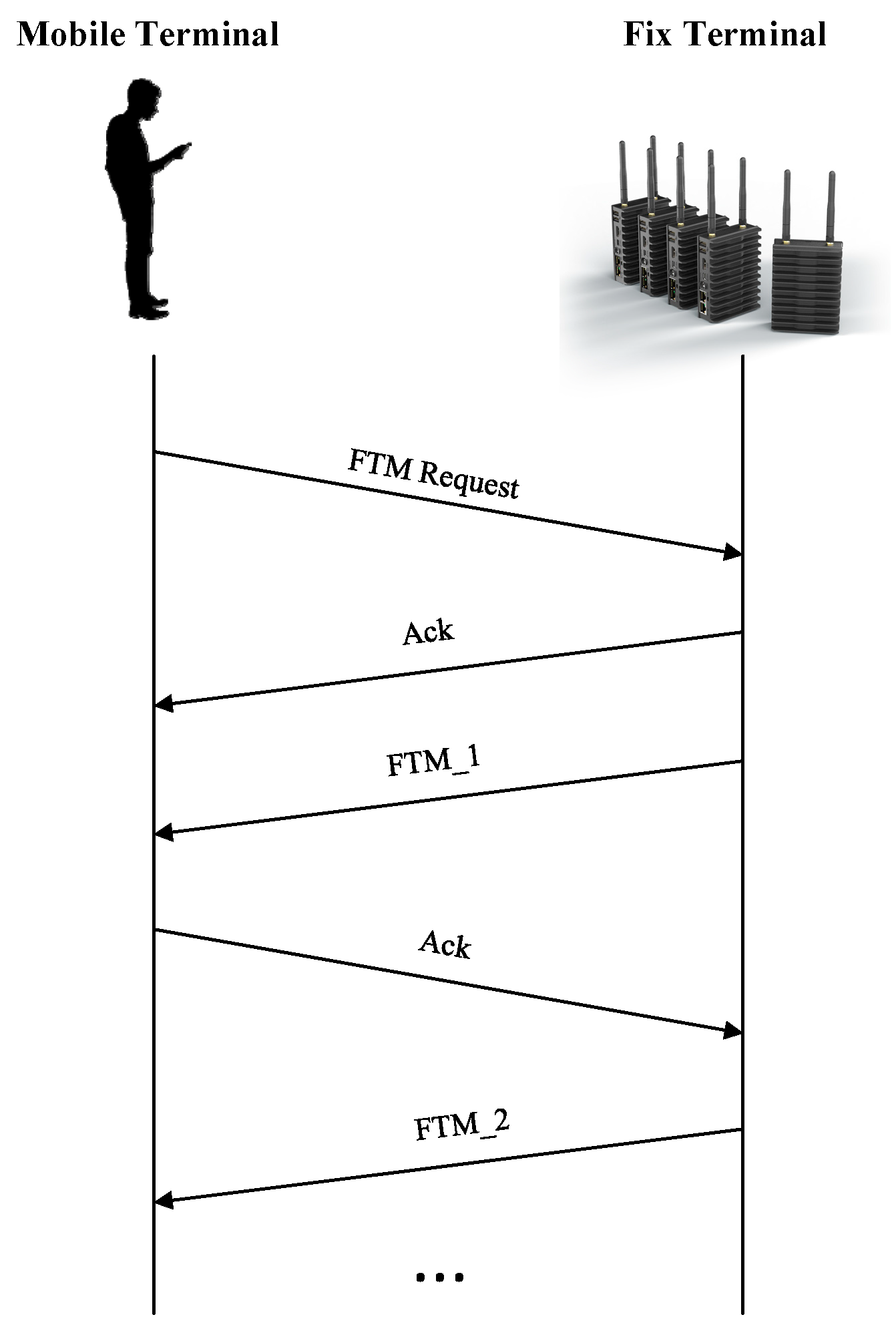

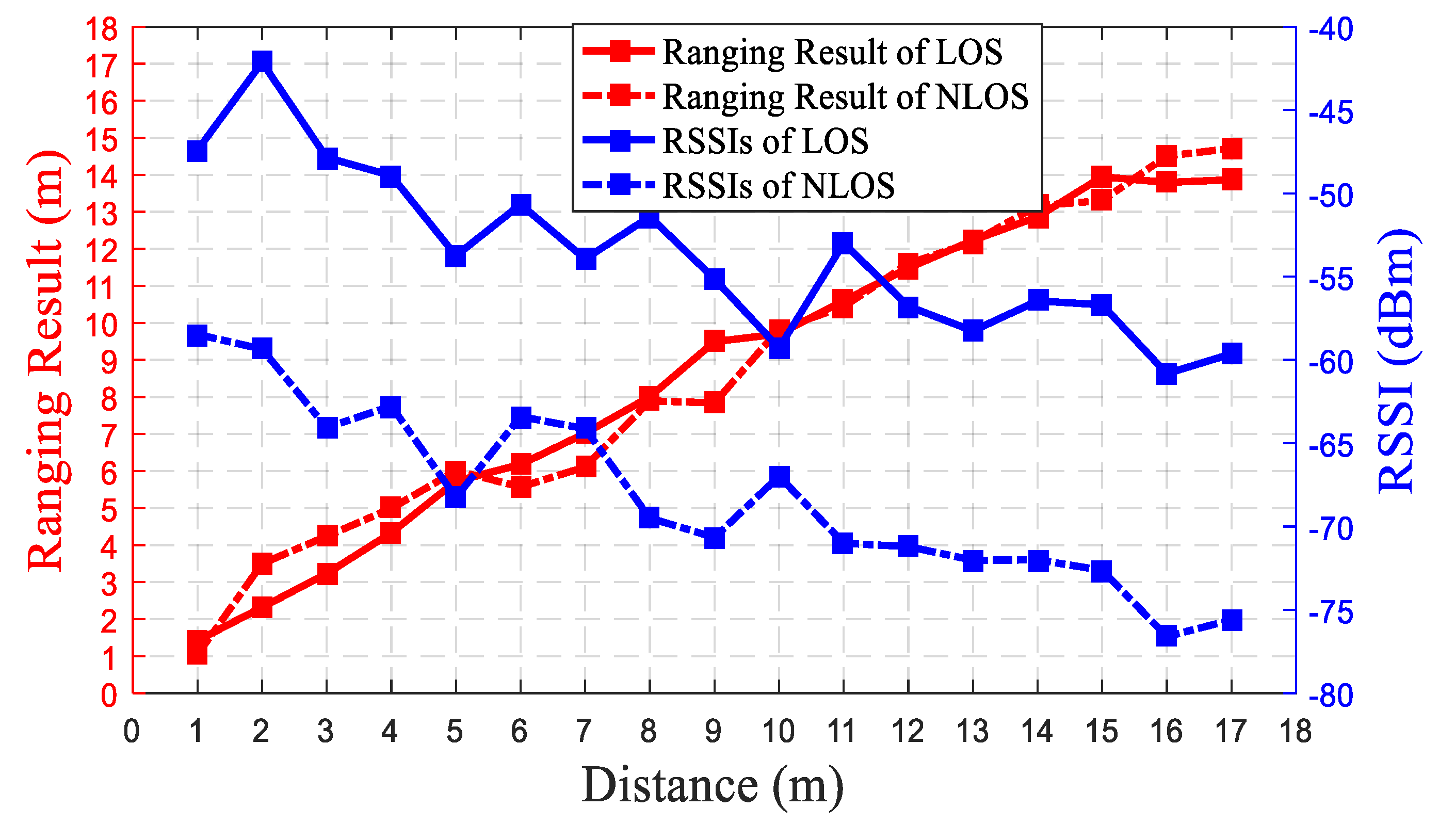

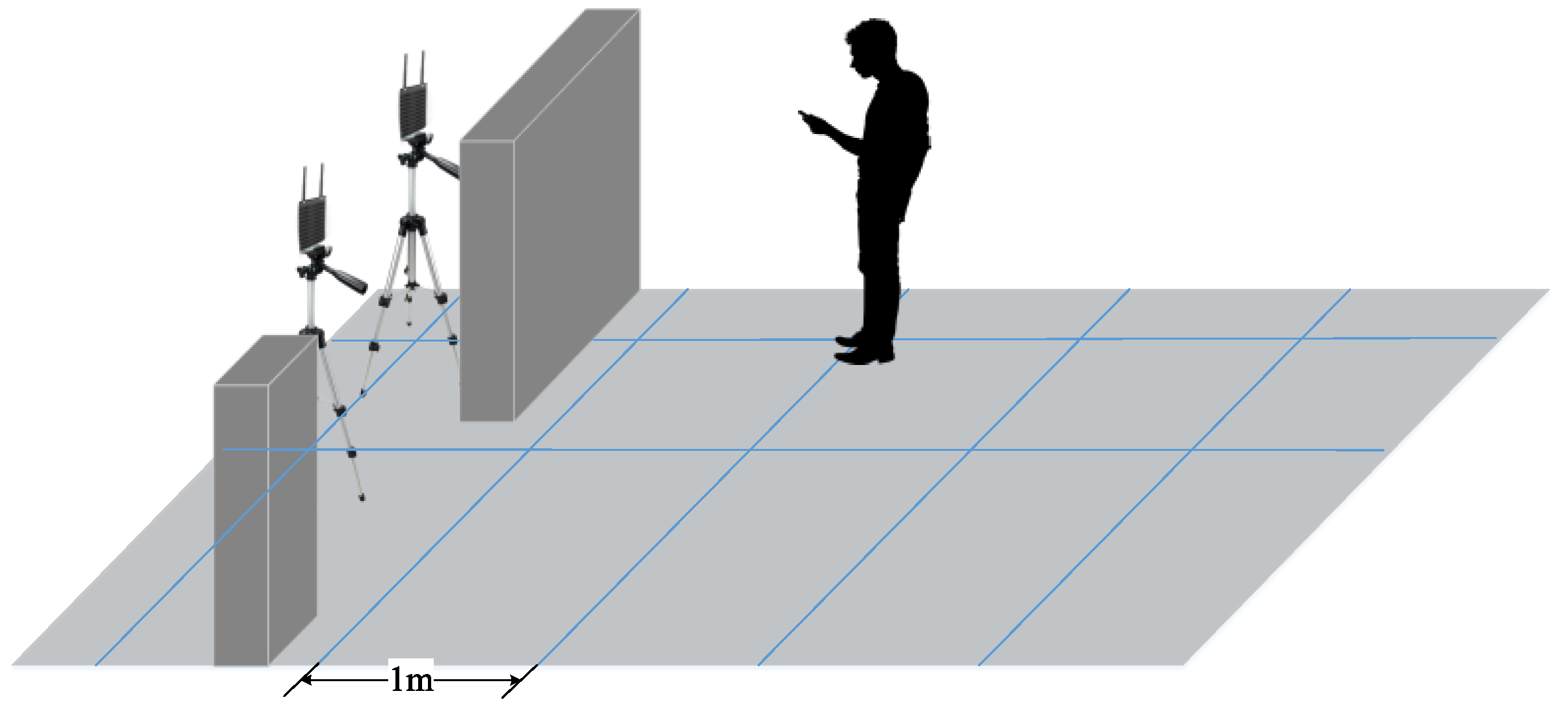
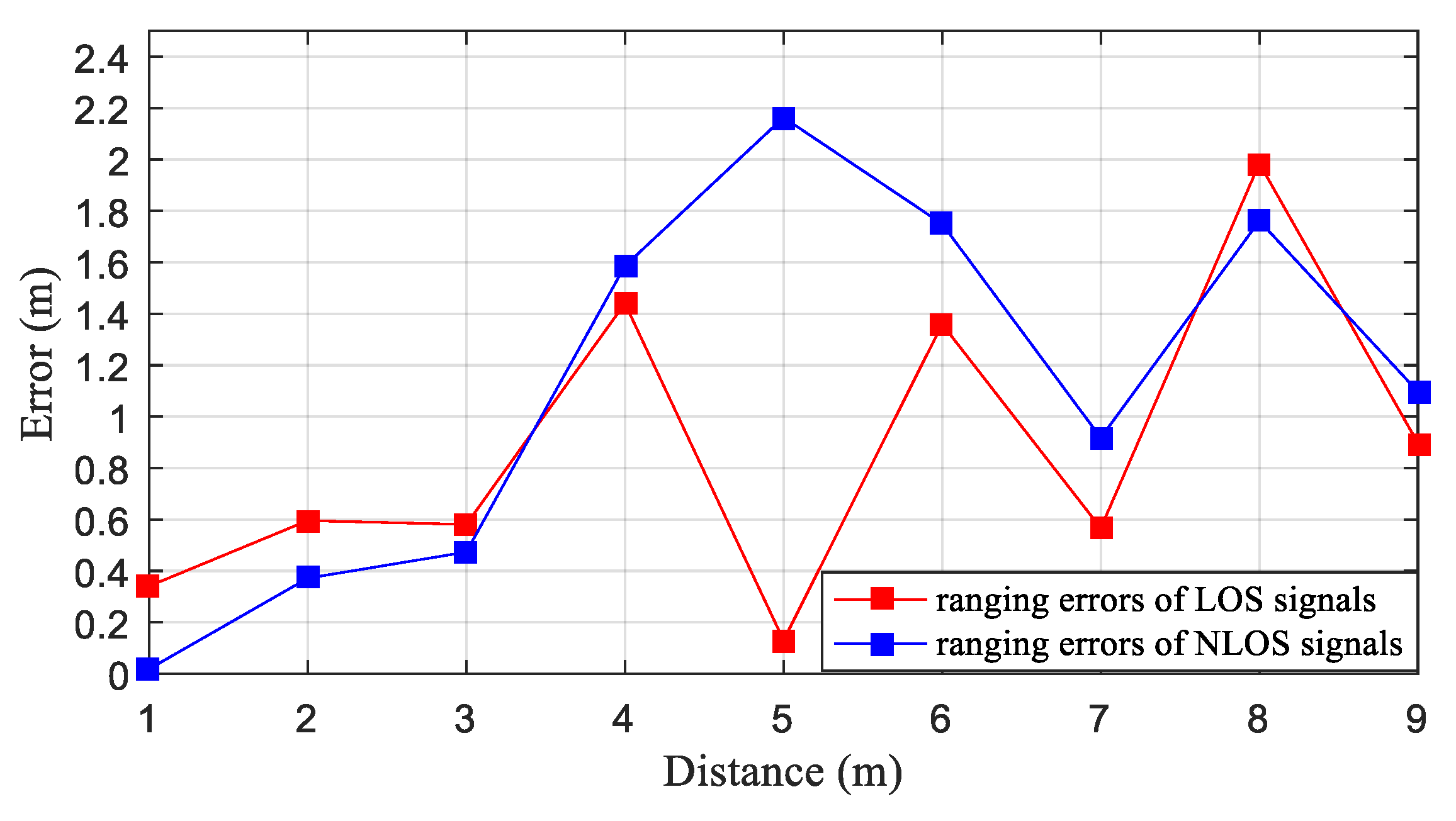
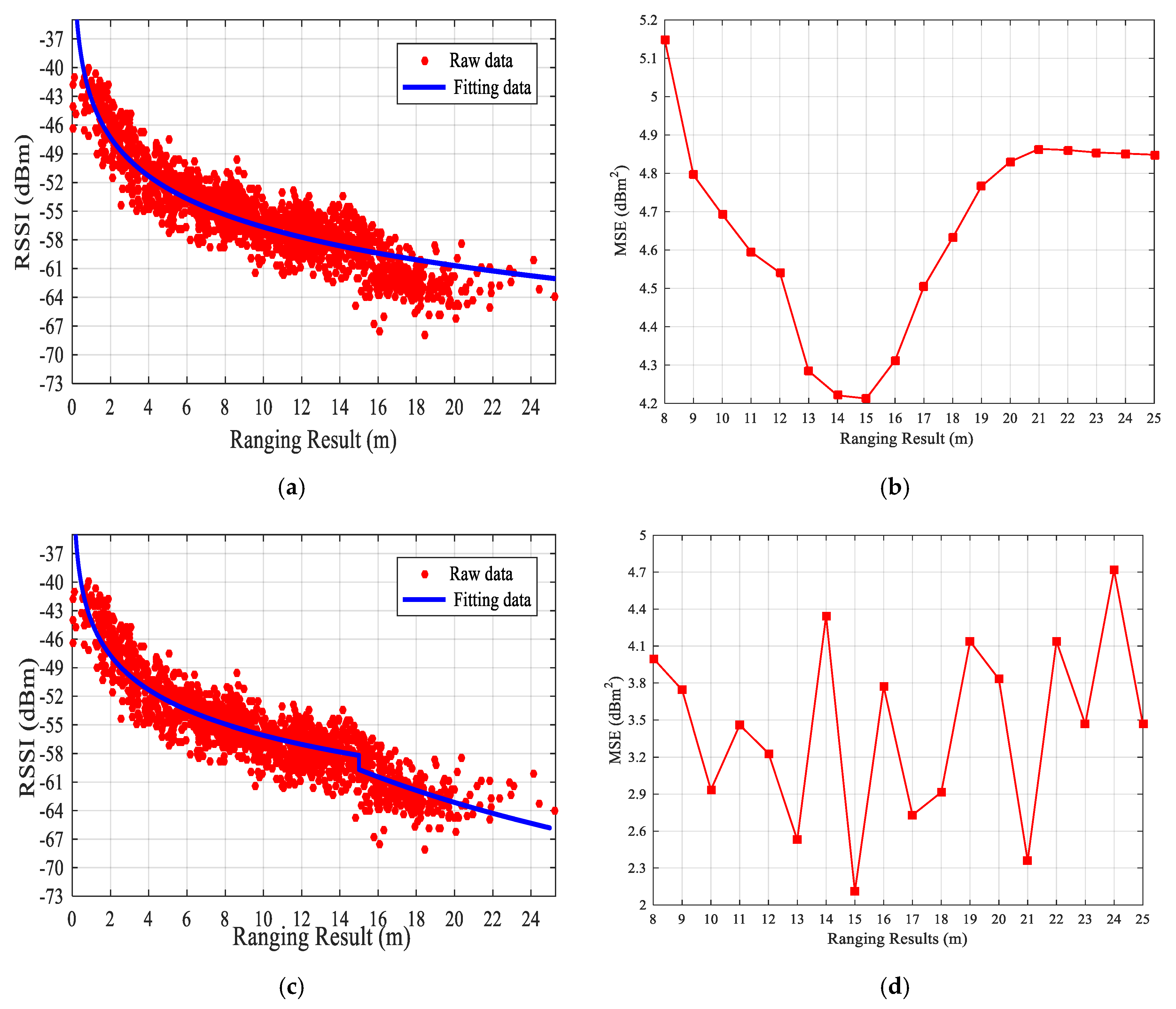
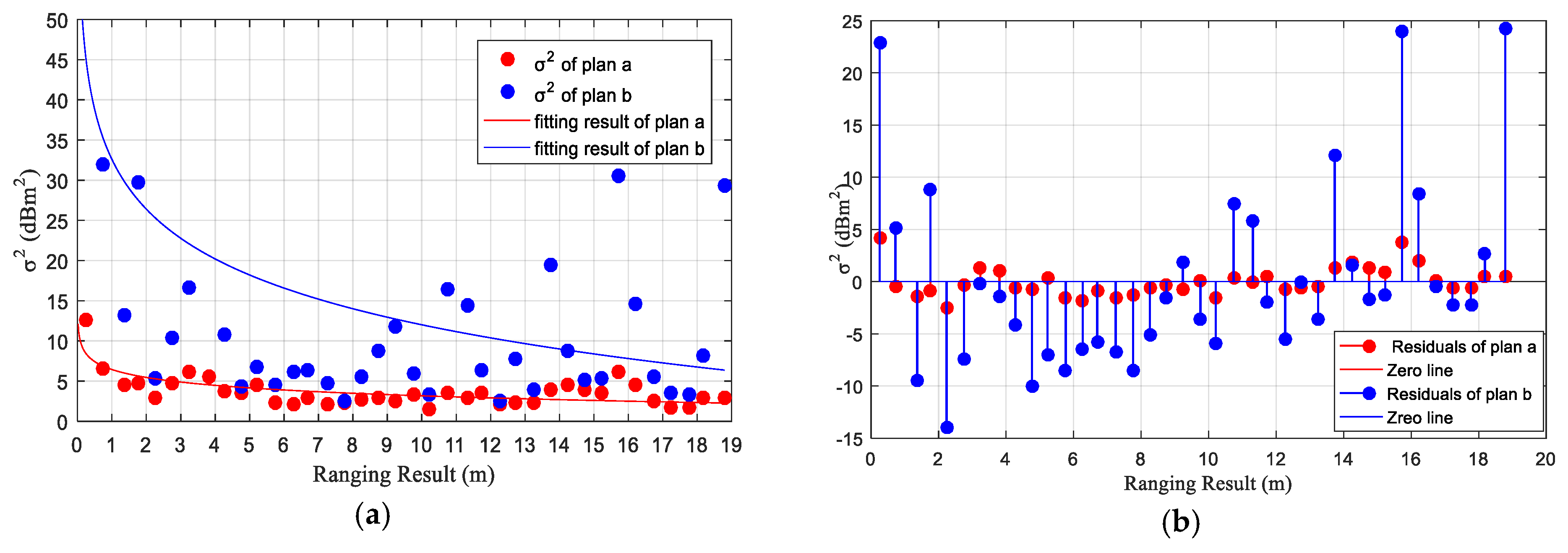
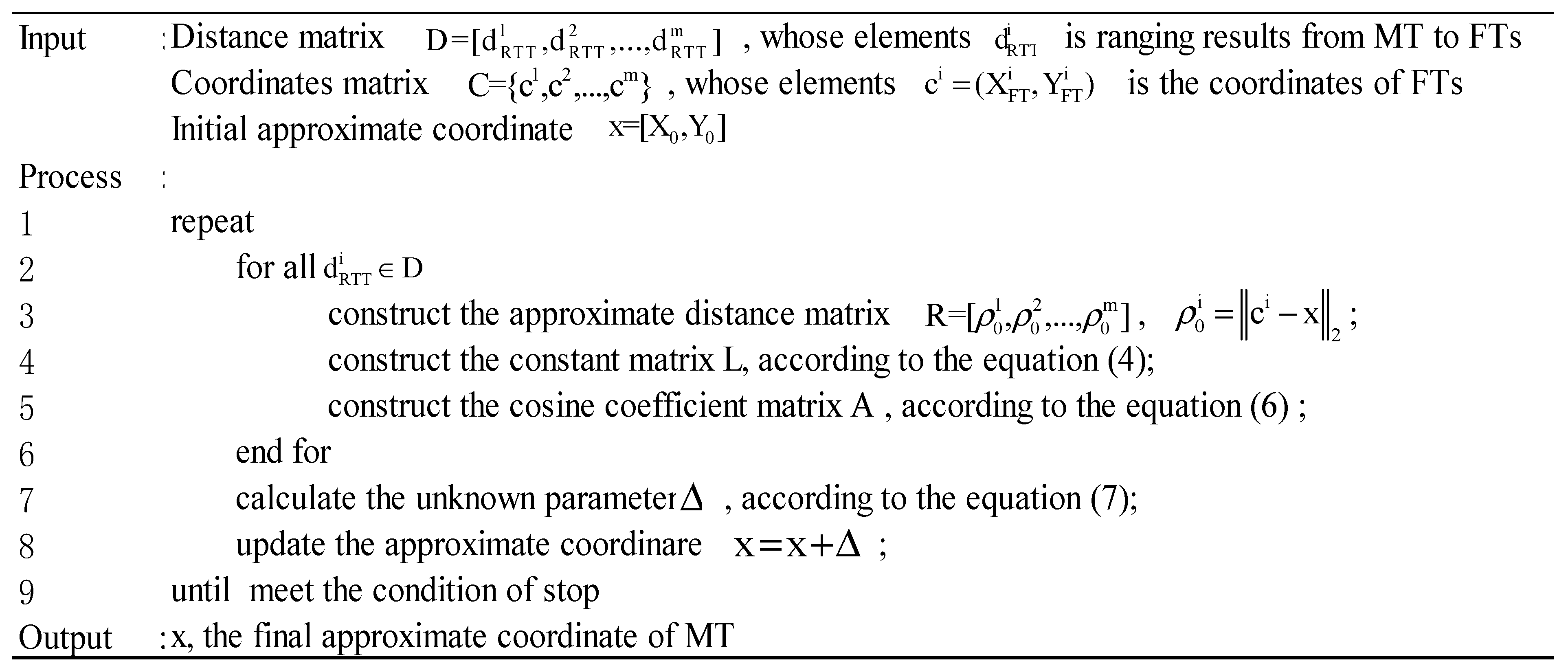

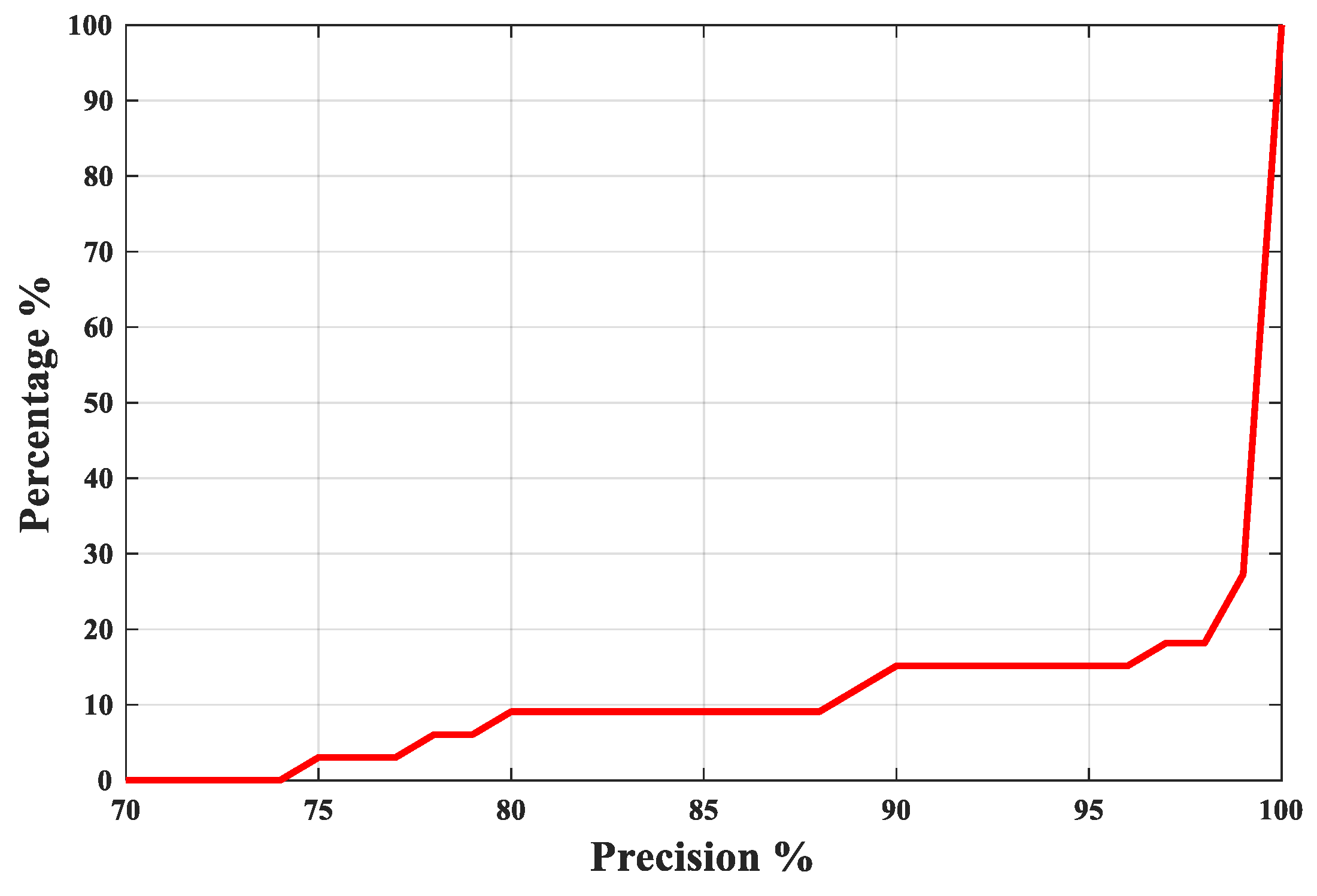



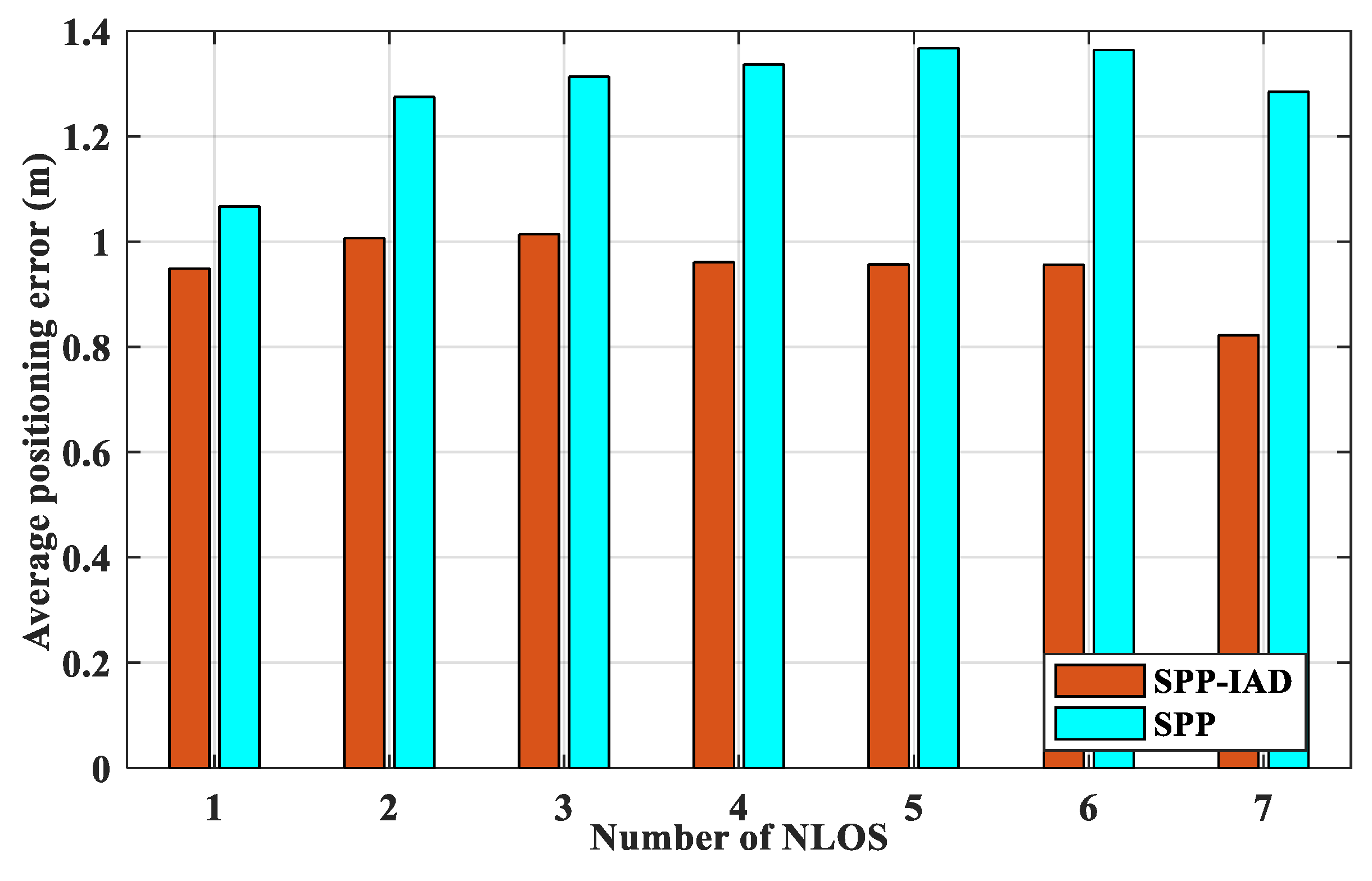
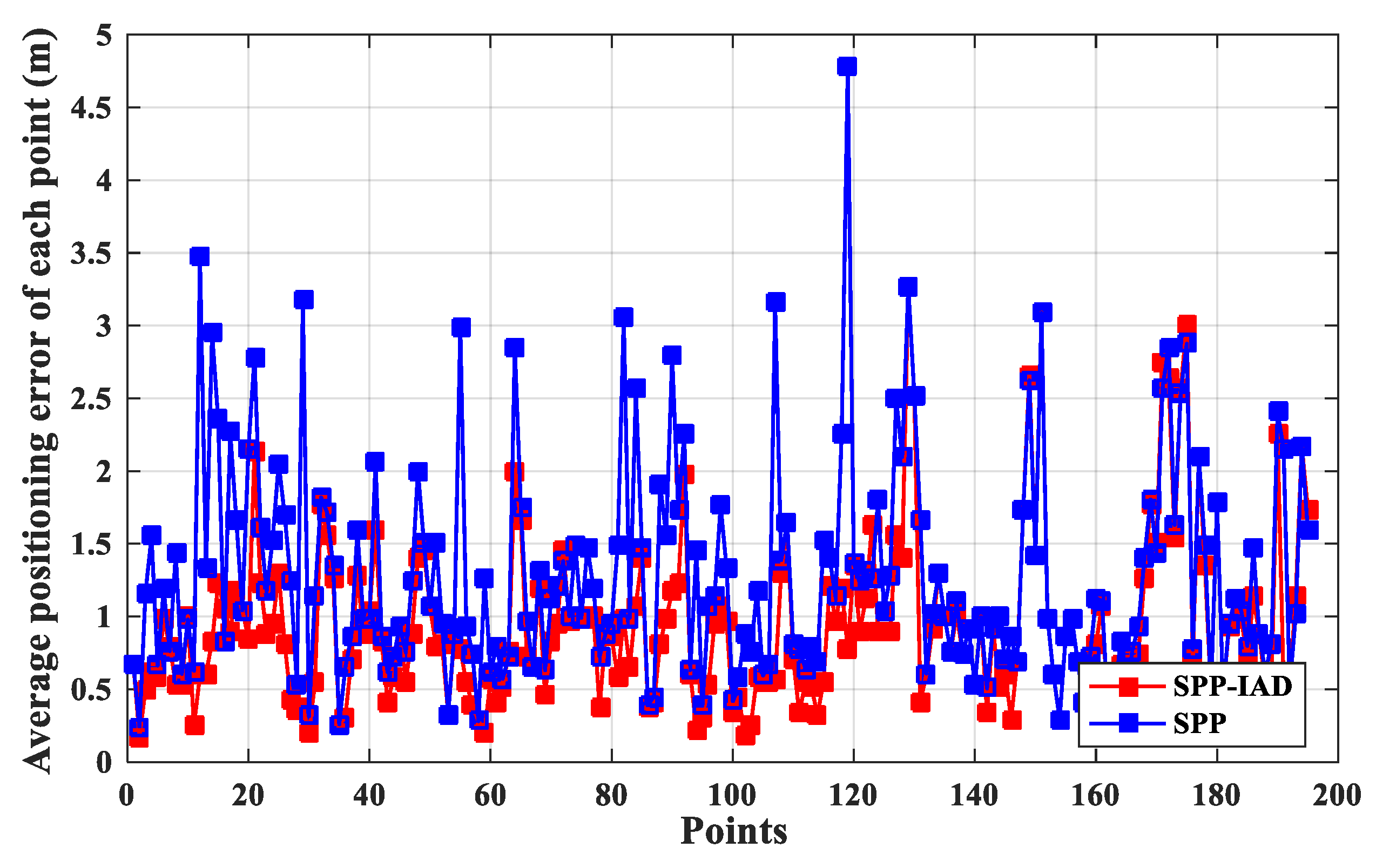
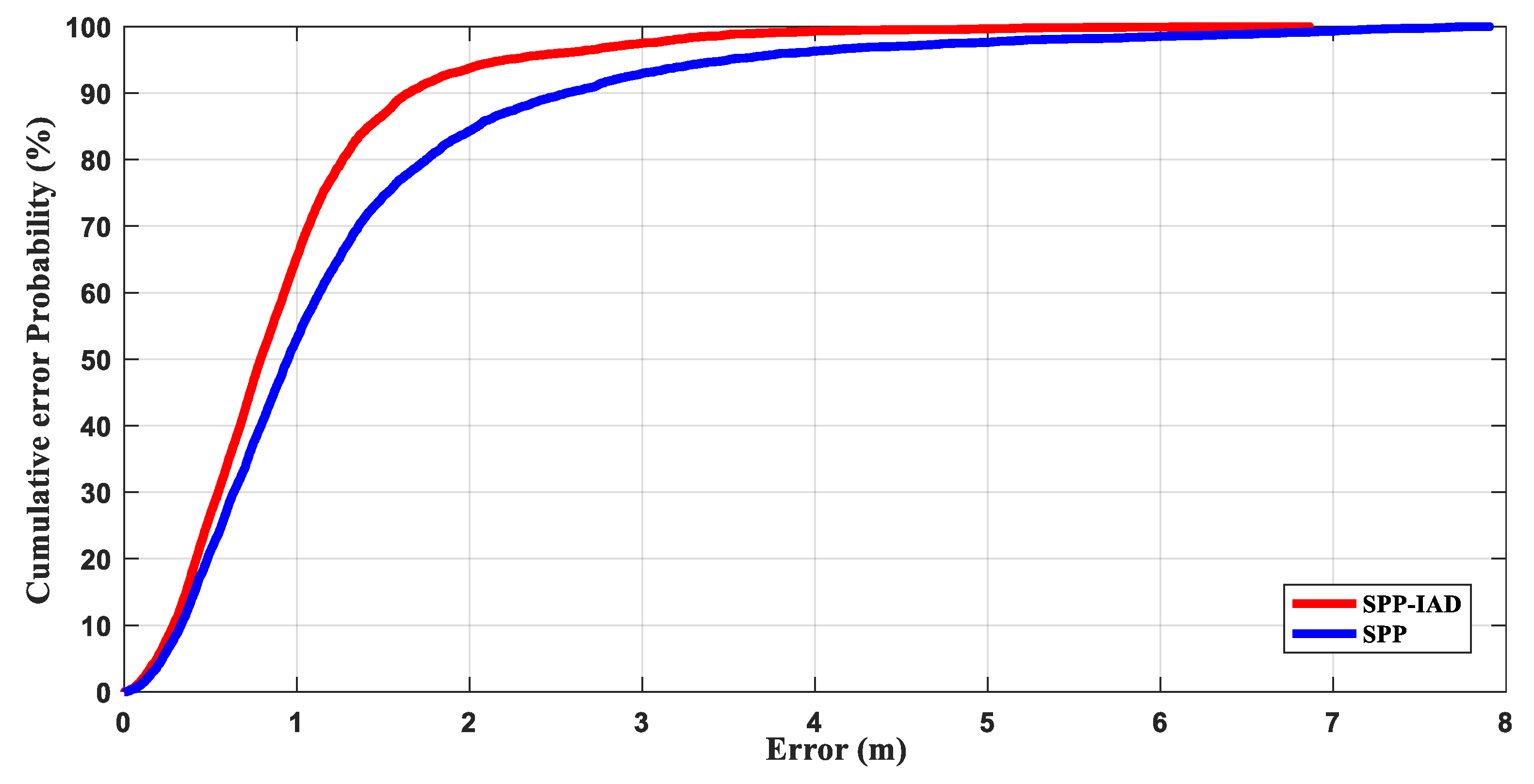
| Obstacle | Reinforced Concrete Wall | Plasterboard Wall | Wooden Door | Metal Door | Glass Window |
|---|---|---|---|---|---|
| Signal Attenuation Value (dBm) | 15–16 | 3–5 | 3–5 | 10–12 | 6–8 |
| Distance Range (m) | 0–3 | 3–6 | 6–9 | 9–12 | 12–15 | 15–18 |
|---|---|---|---|---|---|---|
| σ (dBm) | 3.48 | 2.34 | 1.66 | 1.69 | 1.74 | 1.74 |
| Fitting Function | SSE (dBm2) | R-Square Value |
|---|---|---|
| Our Model | 72.77 | 0.48 |
| Fourier | 85.70 | 0.40 |
| Linear Fitting | 99.85 | 0.30 |
| Polynomial | 115.13 | 0.19 |
| Rational | 92.79 | 0.35 |
| Sum of Sine | 115.14 | 0.19 |
| Method | ME (m) | EM (m) | RMSE (m) |
|---|---|---|---|
| SPP-IAD | 6.862 | 0.932 | 0.712 |
| SPP | 7.903 | 1.272 | 1.268 |
© 2020 by the authors. Licensee MDPI, Basel, Switzerland. This article is an open access article distributed under the terms and conditions of the Creative Commons Attribution (CC BY) license (http://creativecommons.org/licenses/by/4.0/).
Share and Cite
Si, M.; Wang, Y.; Xu, S.; Sun, M.; Cao, H. A Wi-Fi FTM-Based Indoor Positioning Method with LOS/NLOS Identification. Appl. Sci. 2020, 10, 956. https://doi.org/10.3390/app10030956
Si M, Wang Y, Xu S, Sun M, Cao H. A Wi-Fi FTM-Based Indoor Positioning Method with LOS/NLOS Identification. Applied Sciences. 2020; 10(3):956. https://doi.org/10.3390/app10030956
Chicago/Turabian StyleSi, Minghao, Yunjia Wang, Shenglei Xu, Meng Sun, and Hongji Cao. 2020. "A Wi-Fi FTM-Based Indoor Positioning Method with LOS/NLOS Identification" Applied Sciences 10, no. 3: 956. https://doi.org/10.3390/app10030956





